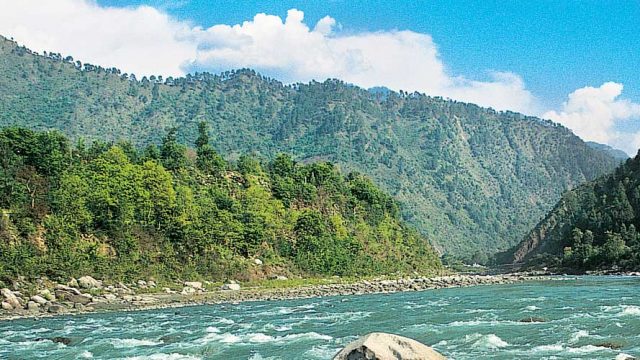The ancient town of Chamba was founded in 920 CE by Raja Sahil Varman who named it after his daughter, Champavati. Bound by the Dhauladhar and Pir Panjal ranges and fed by the great Ravi River, Chamba was a mighty Himalayan kingdom till the British Empire brought it under the colonial administration of undivided Punjab. This town is best known for the artistic traditions of its people and the architectural marvels that were created between the 8th and 10th centuries CE.
THINGS TO SEE AND DO
Chaugan is the public promenade that was used for state durbars and sports till 1890, when the British levelled it and converted it into a cricket field. From here, you can head to the city’s temples, palaces or British edifices.
Of Chamba’s many temples, the Lakshmi Narayan Temple Complex is the largest and the oldest, dating back to the 11th century. The Brajeshwari Devi Temple is interestingly topped by golden pots (kalash) and spirals that are said to have been added in defiance of Aurangzeb’s edict ordering temples to be demolished. Another interesting shrine is the Bansi Gopal Temple. It houses several stone panels from excavations conducted in and around Chamba.

The famous Champavati Temple, with its ornate stone carvings, was built by Raja Sahil Varman in memory of his daughter. The Chamunda Devi Temple, with its intricately carved pillars, roof and beams, offers a magnificent view of the entire town.
The much-touted red-coloured Rang Mahal houses the local employment exchange and Handicrafts Centre. Akhand Chandi Palace (locally also referred to as Raj Mahal), near the Lakshmi Narayan Temple, doubles up as a college. The Bhuri Singh Museum, has a collection of miniatures unique to the region along with murals, a silver elephant throne, Chamba rumaals, weapons, and a coin collection. Chamba has many remnants of the colonial era, including the Post Office which opened in 1863, a Residency (now the Circuit House) which was built for the British Superintendent in 1865,a hospital built in 1891, a courthouse and the Church of Scotland, both builtin the 1890s.
Chamba is famous for its rumaals, chappals, and shawls, along with stone and metal work. You can also pick up a jar of chukh, a mashed chilli pickle that is a speciality of this region.
WHERE TO STAY AND EAT
HPTDC’s Hotel Iravati (Tel: 01899- 222671; Tariff: ₹1,300–2,500) faces the Chaugan. The rooms are large, and Chamban cuisine can be ordered in advance. HPTDC also has a budget wing, Hotel Champak (Tel: 222774; Tariff: ₹1,400–1,600). Hotel Aroma Palace (Tel: 225577, 225677, 225177, Cell: 09418022710; Tariff: ₹1,200–4,000) offers a comfortable stay and great views. Chaugan has quite a few dhabas, especially around Museum Road. HPTDC runs Café Ravi View in Chaugan. Some restaurants offer Chamba madhra (a combination of rajma, dahi and ghee served with rice).
THE INFORMATION
When to go April to October
Tourist Office
HPTDC, Marketing Office, Bachat Bhavan, Next to Hotel Iravati, Chamba, Tel: 01899-224002
STD code 01899
GETTING THERE
Air Nearest airport: Gaggal, Kangra (103km/ 3hrs); Taxi ₹4,000
Rail Chakki Bank (112km/ 3.5hrs); taxi from to Chamba costs ₹3,500
Road Chamba is 49km north of Dalhousie via Khajjiar Bus A Volvo bus (Bus Stand 01899-222210), via Dalhousie, leaves Delhi’s ISBT Kashmere Gate at 8.20pm. The fare is around ₹1,390




